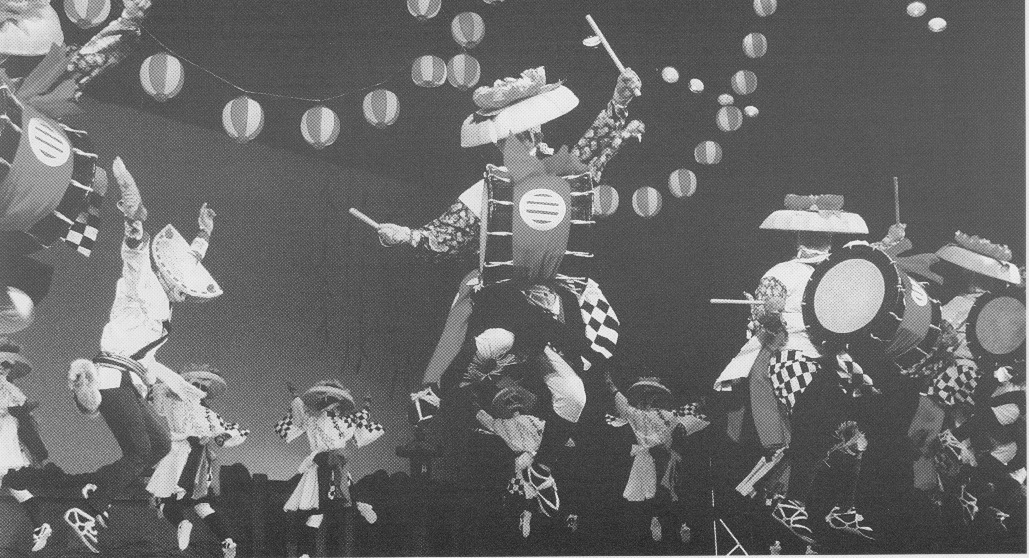About
Sansa Odori

Ensohza Minyoshu at SF Cherry
Blossom '09 |
Sansa Odori is a festival dance that comes from
the Iwate prefecture of Japan's largest island
of Honshu. The most noticeably unique aspect of
Sansa is that dancers, drummers and flute players
all participate by dancing together in unison.
The origins of the dance and the festival are
vague, but one legend has it that some time long
ago a demon or ogre, called an Oni, terrorized
the inhabitants Iwate.
The people prayed to the god Mitsuishi Daigongen
for protection from the oni. Hearing their prayers,
the god punished the oni and banished him to lands
in the north. As a sign of the Oni's pledge, he
was made to place his hand upon one of three stones.
The handprint remained, giving birth to Iwate's
name, which means "stone hand."
Following this victory, the people have celebrated
every summer by participating in the Sansa Odori.
Sanbonyanagi Sansa Odori
Sanbonyanagi Sansa Odori is a specific
style of Sansa maintained by a preservation society
, or hozonkai (ho-zone-kai). This group, lead
by Kiyomi Fujisawa, performs this version of the
dance at religious dedications, festivals and
on stage as well as during the Morioka Sansa Festival.
The group meets weekly to rehearse year-round
in the small building they constructed on a farm
road on the outskirts of Morioka City, the capital
of Iwate.
Sanbonyanagi Sansa Odori gets its
name from the village of its origin, Sanbonyanagi
(sahn-bone-yah-nah-gee), which means "three
willows". It is a very dynamic style danced
to a powerful drum beat and lively song of flutes,
where all participants step, leap and turn in
unison, regardless of whether they are dancing,
playing the large drums strapped to their chests,
or playing a melody on the flute.
Drums
Sansa Odori uses a type of drum
called an Okedo (oh-kay-doh) or Oke-Daiko, meaning
"bucket drum." This relatively lightweight
drum is made of a wooden stave-constructed body.
The drum heads are generally made from cow hide
sewn tightly onto a metal ring. The two drum heads
are laced to each other, sandwiching the drum
body between them, with the tension of the rope
holding the drum together.
The Okedo is worn strapped to the
drummer chest with the drum heads facing to the
sides. It is played by striking the heads with
wooden sticks called bachi (bah-chee).
Flutes
The flutes used in the Sansa Odori
are called Shinobue (she-no-boo-eh), or simply
fue (foo-eh). Fue are transverse flutes made from
bamboo and are found in every region and festival
in Japan. They are available in many sizes and
styles. The flutes used are traditionally not
tuned to a western scale, giving them a truly
Japanese festival sound.
The flute's pitch is determined
by its length – the larger the flute, the
lower the pitch.
Costumes

Stage performance by the
Sanbonyanagi Sansa Odori Hozonkai in Japan |
Sanbonyanagi dancers, drummers and
flute players wear the same baisc costume consisting
of a yukata, or summer kimono, with several colorful
strips of cloth tied around the waist. The yukata
is tucked up slightly, giving the legs more freedom
of movement, while the arms and the backs of the
hands are covered by a cloth wrapping called tekko.
Underneath the yukata, thin white
pants called momohiki are worn with dark color
leggings called kyahan tied around the shins.
Traditionally, a split toed sock called tabi are
worn with straw sandals called waraji.
The hat is a large flat bowl shape
made from straw. The dancers wear flowers or paper
flowers on the hats. The flower covered hats are
called hanagasa or "flower hats."
Ippachi
There is one lead dancer called
the Ippachi (eep-pah-chee) whose costume stands
apart from the rest. This is based on a traditional
comic figure called Hyotoko (hyoh-toh-koh). This
dancer serves to help communicate instructions
from the leader of the dancing, which is actually
one of the drummers called the Ichiban-Daiko (ee-chee-bahn-die-koh)
and also dances solo during special slow parts
of the songs.
|